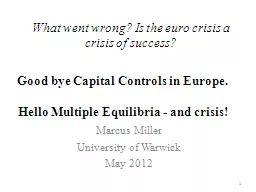PPT-What went wrong? Is the euro crisis a crisis of success?
Author : cheryl-pisano | Published Date : 2016-03-15
Marcus Miller University of Warwick May 2012 1 Good bye Capital Controls in Europe Hello Multiple Equilibria and crisis First some history when Germany was debtor
Presentation Embed Code
Download Presentation
Download Presentation The PPT/PDF document "What went wrong? Is the euro crisis a cr..." is the property of its rightful owner. Permission is granted to download and print the materials on this website for personal, non-commercial use only, and to display it on your personal computer provided you do not modify the materials and that you retain all copyright notices contained in the materials. By downloading content from our website, you accept the terms of this agreement.
What went wrong? Is the euro crisis a crisis of success?: Transcript
Download Rules Of Document
"What went wrong? Is the euro crisis a crisis of success?"The content belongs to its owner. You may download and print it for personal use, without modification, and keep all copyright notices. By downloading, you agree to these terms.
Related Documents














